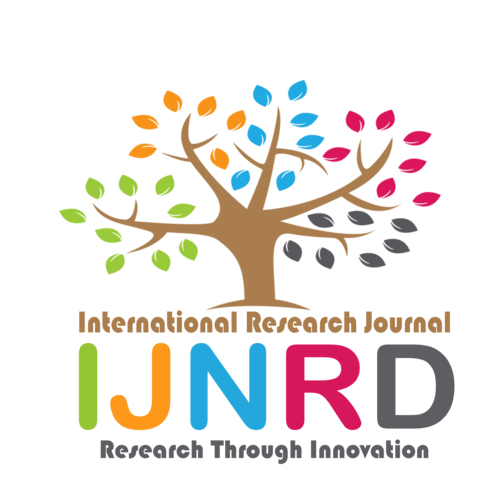|
|||||||||||||||

|
INTERNATIONAL JOURNAL OF NOVEL RESEARCH AND DEVELOPMENT International Peer Reviewed & Refereed Journals, Open Access Journal ISSN Approved Journal No: 2456-4184 | Impact factor: 8.76 | ESTD Year: 2016 Scholarly open access journals, Peer-reviewed, and Refereed Journals, Impact factor 8.76 (Calculate by google scholar and Semantic Scholar | AI-Powered Research Tool) , Multidisciplinary, Monthly, Indexing in all major database & Metadata, Citation Generator, Digital Object Identifier(DOI) |
||||||||||||||
Issue: April 2024
Volume 9 | Issue 4
Review Result and Publication of Paper within : 2-3 days
Click Here For more DetailsFor Authors
Forms / Download
Published Issue Details
Editorial Board
Other IMP Links
Facts & Figure
Impact Factor : 8.76
Issue per Year : 12
Volume Published : 9
Issue Published : 95
Article Submitted :
Article Published :
Total Authors :
Total Reviewer :
Total Countries :
Indexing Partner
Join RMS/Earn 300
Licence
This work is licensed under a Creative Commons Attribution-NonCommercial 4.0 International License







|
Published Paper Details
|
|
| Paper Title: | Rain Prediction Using Machine Learning |
| Authors Name: | Vijithra Nair , Megha Mathew , Sweta Bhattacharjee , Arashdip Singh , Prof. Payel Thakur |
| Download E-Certificate: | Download |
| Author Reg. ID: |
IJNRD_180981
|
| Published Paper Id: | IJNRD2204082 |
| Published In: | Volume 7 Issue 4, April-2022 |
| DOI: | |
| Abstract: | As agriculture being the key point of survival, Rainfall is the important source for its cultivation. Rainfall prediction has always been a major problem as prediction of rainfall gives awareness to people and to know in advance about rain so as to take necessary precautions to protect their crops from rain. A particular dataset is taken from Kaggle community and this project predicts whether it will rain tomorrow or not by using the rainfall in dataset. CatBoost model is implemented in this project as it is an open sourced machine learning algorithm, and features great quality without the parameter tuning, categorical feature support, improved accuracy and fast prediction. CatBoost model is a gradient boosting toolkit and two critical algorithms classical and innovative are introduced to create a fight in prediction shift present in currently existing implementations of gradient boosting algorithms. CatBoost performed very well giving an AUC (Area under curve) score 0.8 and ROC ( Receiver operating characteristic curve) score as 89. ROC is called as an evaluating curve whereas AUC presents a degree or measure of separability as the model is skilled enough to distinguish between classes. An Exploratory data analysis is done to examine data distribution, outliers and provides tools for visualizing and understanding the data through graphical representation. A dashboard is implemented to showcase the information that is represented in datasets i.e. any changes in the data will result in different types of graphs. A linear SVC (Support vector classifier) provides a best fit hyperplane that divides the data and feeds some features to the classifier to detect what the predicted class is and results in desired output. |
| Keywords: | ARIMA, CatBoost, Random Forest, Rainfall prediction, XgBoost |
| Cite Article: | "Rain Prediction Using Machine Learning", International Journal of Novel Research and Development (www.ijnrd.org), ISSN:2456-4184, Vol.7, Issue 4, page no.687-693, April-2022, Available :http://www.ijnrd.org/papers/IJNRD2204082.pdf |
| Downloads: | 000118757 |
| ISSN: |
2456-4184 | IMPACT FACTOR: 8.76 Calculated By Google Scholar| ESTD YEAR: 2016 An International Scholarly Open Access Journal, Peer-Reviewed, Refereed Journal Impact Factor 8.76 Calculate by Google Scholar and Semantic Scholar | AI-Powered Research Tool, Multidisciplinary, Monthly, Multilanguage Journal Indexing in All Major Database & Metadata, Citation Generator |
| Publication Details: |
Published Paper ID:IJNRD2204082 Registration ID: 180981 Published In: Volume 7 Issue 4, April-2022 DOI (Digital Object Identifier): Page No: 687-693 Country: Navi Mumbai/Raigarh, Maharashtra, India Research Area: Computer Engineering Publisher : IJ Publication Published Paper URL : https://www.ijnrd.org/viewpaperforall?paper=IJNRD2204082 Published Paper PDF: https://www.ijnrd.org/papers/IJNRD2204082 |
| Share Article: | |
|
Click Here to Download This Article |
|
| Article Preview | |
|
|
|
Major Indexing from www.ijnrd.org
| Semantic Scholar | Microsaoft Academic | ORCID | Zenodo |
| Google Scholar | ResearcherID Thomson Reuters | Mendeley : reference manager | Academia.edu |
| arXiv.org : cornell university library | Research Gate | CiteSeerX | PUBLON |
| DRJI | SSRN | Scribd | DocStoc |
ISSN Details
 |
 |
ISSN: 2456-4184
Impact Factor: 8.76 and ISSN APPROVED
Journal Starting Year (ESTD) : 2016
DOI (A digital object identifier)
Conference
Open Access License Policy
Important Details
Social Media
| Copyright © 2024 - All Rights Reserved - IJNRD |












Facebook Twitter Instagram LinkedIn